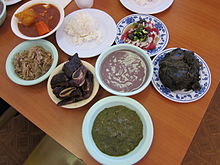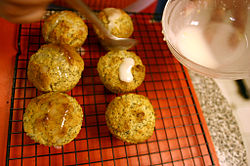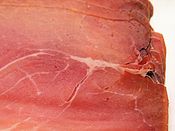Portal:Food
F o o d
A portal dedicated to food and foodways
Introduction


Food is any substance consumed by an organism for nutritional support. Food is usually of plant, animal, or fungal origin and contains essential nutrients such as carbohydrates, fats, proteins, vitamins, or minerals. The substance is ingested by an organism and assimilated by the organism's cells to provide energy, maintain life, or stimulate growth. Different species of animals have different feeding behaviours that satisfy the needs of their metabolisms and have evolved to fill a specific ecological niche within specific geographical contexts.
Omnivorous humans are highly adaptable and have adapted to obtain food in many different ecosystems. Humans generally use cooking to prepare food for consumption. The majority of the food energy required is supplied by the industrial food industry, which produces food through intensive agriculture and distributes it through complex food processing and food distribution systems. This system of conventional agriculture relies heavily on fossil fuels, which means that the food and agricultural systems are one of the major contributors to climate change, accounting for as much as 37% of total greenhouse gas emissions. (Full article...)
Cooking, also known as cookery or professionally as the culinary arts, is the art, science and craft of using heat to make food more palatable, digestible, nutritious, or safe. Cooking techniques and ingredients vary widely, from grilling food over an open fire, to using electric stoves, to baking in various types of ovens, reflecting local conditions. Cooking is an aspect of all human societies and a cultural universal.
Preparing food with heat or fire is an activity unique to humans. Archeological evidence of cooking fires from at least 300,000 years ago exists, but some estimate that humans started cooking up to 2 million years ago.
The expansion of agriculture, commerce, trade, and transportation between civilizations in different regions offered cooks many new ingredients. New inventions and technologies, such as the invention of pottery for holding and boiling of water, expanded cooking techniques. Some modern cooks apply advanced scientific techniques to food preparation to further enhance the flavor of the dish served. (Full article...)

KFC (also commonly referred to by its historical name Kentucky Fried Chicken) was founded by Colonel Harland Sanders, an entrepreneur who began selling fried chicken from his roadside restaurant in Corbin, Kentucky, during the Great Depression. Sanders identified the potential of restaurant franchising, and the first "Kentucky Fried Chicken" franchise opened in Salt Lake City, Utah, in 1952. KFC popularized chicken in the fast-food industry, diversifying the market by challenging the established dominance of the hamburger. Branding himself "Colonel Sanders", the founder became a prominent figure of American cultural history, and his image remains widely used in KFC advertising. The company's rapid expansion made it too large for Sanders to manage, so in 1964 he sold the company to a group of investors led by John Y. Brown Jr. and Jack C. Massey.
KFC was one of the first fast-food chains to expand internationally, opening outlets in Britain, Mexico, and Jamaica by the mid-1960s. Throughout the 1970s and 80s, KFC experienced mixed success domestically, as it went through a series of changes in corporate ownership with little or no experience in the restaurant business. In the early 1970s, KFC was sold to the spirits distributor Heublein, which was taken over by the R. J. Reynolds food and tobacco conglomerate, which later sold the chain to PepsiCo. The chain continued to expand overseas, and in 1987 KFC became the first Western restaurant chain to open in China. (Full article...)
Selected article –
The World Food Programme (WFP) is an international organization within the United Nations that provides food assistance worldwide. It is the world's largest humanitarian organization and the leading provider of school meals. Founded in 1961, WFP is headquartered in Rome and has offices in 87 countries. In 2023 it supported over 152 million people, and is present in more than 120 countries and territories.
In addition to emergency food relief, WFP offers technical and development assistance, such as building capacity for emergency preparedness and response, managing supply chains and logistics, promoting social safety programs, and strengthening resilience against climate change. It is also a major provider of direct cash assistance, and provides passenger services for humanitarian workers through its management of the United Nations Humanitarian Air Service (UNHAS). (Full article...)
Selected cuisine -
The cuisine of Hawaii incorporates five distinct styles of food, reflecting the diverse food history of settlement and immigration in the Hawaiian Islands, primarily originating from Polynesian, North American and East Asian cuisines.[a]
In the pre-contact period of Ancient Hawaii (300 AD–1778), Polynesian voyagers brought plants and animals to the Islands. As Native Hawaiians settled the area, they fished, raised taro for poi, planted coconuts, sugarcane, sweet potatoes and yams, and cooked meat and fish in earth ovens. (Full article...)
Selected ingredient –

Flour is a powder made by grinding raw grains, roots, beans, nuts, or seeds. Flours are used to make many different foods. Cereal flour, particularly wheat flour, is the main ingredient of bread, which is a staple food for many cultures. Corn flour has been important in Mesoamerican cuisine since ancient times and remains a staple in the Americas. Rye flour is a constituent of bread in both Central Europe and Northern Europe.
Cereal flour consists either of the endosperm, germ, and bran together (whole-grain flour) or of the endosperm alone (refined flour). Meal is either differentiable from flour as having slightly coarser particle size (degree of comminution) or is synonymous with flour; the word is used both ways. For example, the word cornmeal often connotes a grittier texture whereas corn flour connotes fine powder, although there is no codified dividing line.Selected recipe –
The muffins pictured are a variation on the classic lemon poppy seed muffin. Made with real lemon zest and covered with a lemon-flavored confectioners glaze, they are an ideal companion for a Sunday brunch.
Eliza Acton (17 April 1799 – 13 February 1859) was an English food writer and poet who produced one of Britain's first cookery books aimed at the domestic reader, Modern Cookery for Private Families. The book introduced the now-universal practice of listing ingredients and giving suggested cooking times for each recipe. It included the first recipes in English for Brussels sprouts and for spaghetti. It also contains the first recipe for what Acton called "Christmas pudding"; the dish was normally called plum pudding, recipes for which had appeared previously, although Acton was the first to put the name and recipe together.
Acton was born in 1799 in Sussex. She was raised in Suffolk where she ran a girls' boarding school before spending time in France. On her return to England in 1826 she published a collection of poetry and released her cookery book in 1845, aimed at middle class families. Written in an engaging prose, the book was well received by reviewers. It was reprinted within the year and several editions followed until 1918, when Longman, the book's publisher, took the decision not to reprint. In 1857 Acton published The English Bread-Book for Domestic Use, a more academic and studious work than Modern Cookery. The work consisted of a history of bread-making in England, a study of European methods of baking and numerous recipes. (Full article...)
Selected image –
Selected biography –
B. April 1, 1755, Belley, France – d. February 2, 1826, Paris
"Tell me what you eat, and I will tell you what you are."
Brillat-Savarin
Jean Anthelme Brillat-Savarin (French pronunciation: [ʒɑ̃ ɑ̃tɛlm bʁija savaʁɛ̃], (2 April 1755 – 2 February 1826) was a French lawyer and politician, who, as the author of Physiologie du goût (The Physiology of Taste), became celebrated for his culinary reminiscences and reflections on the craft and science of cookery and the art of eating.
Rising to modest eminence in the last years of France's Ancien Régime, Brillat-Savarin had to escape into exile when the Reign of Terror began in 1793. He spent nearly three years in the United States, teaching French and playing the violin to support himself, before returning to France when it became safe to do so, resuming his career as a lawyer, and rising to the top of the French judiciary. (Full article...)
Did you know (auto-generated) –

- ... that an investigation found that most Mexican nutrition science students could not interpret a nutritional front-of-package labeling system correctly?
- ... that Ice Spice is Princess Diana?
- ... that not all military rations are food?
- ... that on July 11, 2022, millions of dollars worth of jewelry was stolen from the back of a truck while one driver was getting food at a California truck stop and the other one was asleep in the cab?
- ... that the Cantonese cooking channel Made With Lau began generating about US$50,000 per month in YouTube advertising revenue in under a year?
- ... that the small fish species Poecilia vandepolli solves food shortage problems by eating its own offspring?
More did you know –
Related portals
Food topics
The following are topics relating to food
Categories
Food list articles
- See also: Lists of foods and Category:Lists of drinks
The following are some Food list articles on Wikipedia:

- American cheeses
- Appellation d'Origine Contrôlée cheeses
- Apple cultivars
- Bacon dishes
- Bacon substitutes
- Basil cultivars
- Breads
- Breakfast beverages
- Breakfast cereals
- Breakfast foods
- British cheeses
- Cakes
- Candies
- Cheeses
- Cheese soups
- Christmas dishes (list)
- Cocktails
- Cookies
- Dishes using coconut milk
- Diets
- Doughnut varieties
- Egg dishes
- Fermented soy products
- Food additives
- Food additives (Codex Alimentarius)
- Foods named after people
- French cheeses
- French dishes
- Fried dough foods
- Fruits
- List of hamburgers
- Herbs and spices
- Hors d'oeuvre
- Indian dishes
- Indian snack foods
- Indonesian dishes
- Italian dishes
- Japanese snacks
- Japanese dishes
- Jewish dishes
- Kebabs
- Korean beverages
- Mango cultivars
- Moroccan dishes
- Pasta
- Pastries
- Philippine snack food
- Pies, tarts and flans
- Poppy seed pastries and dishes
- Potato dishes
- Puddings
- Raw fish dishes
- Rice dishes
- Rolled foods
- Sauces
- Seafood
- Seeds
- Sandwiches
- Snack foods
- Soft drinks by country
- Soul foods and dishes
- Soups
- Stews
- Street foods
- Tapas
- Turkish dishes
- Twice-baked foods
- Vegetable oils
- Vegetables
- Vodkas
Things you can do
Related WikiProjects
| Parent project: WikiProject Food and Drink | |
| Child projects: | Task forces: (All inactive) |
|
|
| Related projects: | |
New articles
Rules | Match log | Results page (for watching) | Last updated: 2024-10-17 19:16 (UTC)
Note: The list display can now be customized by each user. See List display personalization for details.
- Biscotti di San Martino (edit | talk | history | links | watch | logs | tools) by OppidumNissenae (talk · contribs · new pages (9)) started on 2024-10-17, score: 30
- Cassatella di Agira (edit | talk | history | links | watch | logs | tools) by OppidumNissenae (talk · contribs · new pages (9)) started on 2024-10-16, score: 30
- Ossa di morto (edit | talk | history | links | watch | logs | tools) by OppidumNissenae (talk · contribs · new pages (9)) started on 2024-10-15, score: 30
- Saratoga Water (edit | talk | history | links | watch | logs | tools) by Wil540 art (talk · contribs · new pages (20)) started on 2024-10-15, score: 20
- Flora Food Group (edit | talk | history | links | watch | logs | tools) by Cloudbound (talk · contribs · new pages (1)) started on 2024-10-14, score: 40
- Suguru Fukuda (edit | talk | history | links | watch | logs | tools) by TSUBAME98 (talk · contribs · new pages (7)) started on 2024-10-14, score: 10
- Kenya Suzuki (edit | talk | history | links | watch | logs | tools) by TSUBAME98 (talk · contribs · new pages (7)) started on 2024-10-14, score: 10
- Kōta Tatsu (edit | talk | history | links | watch | logs | tools) by TSUBAME98 (talk · contribs · new pages (7)) started on 2024-10-14, score: 10
- Takahide Ikeda (edit | talk | history | links | watch | logs | tools) by TSUBAME98 (talk · contribs · new pages (7)) started on 2024-10-14, score: 10
- Tsubasa Nabatame (edit | talk | history | links | watch | logs | tools) by TSUBAME98 (talk · contribs · new pages (7)) started on 2024-10-14, score: 10
- Shōma Kanemura (edit | talk | history | links | watch | logs | tools) by TSUBAME98 (talk · contribs · new pages (7)) started on 2024-10-14, score: 10
- Taiki Narama (edit | talk | history | links | watch | logs | tools) by TSUBAME98 (talk · contribs · new pages (7)) started on 2024-10-14, score: 10
- Sure Shot Burger (edit | talk | history | links | watch | logs | tools) by Another Believer (talk · contribs · new pages (65)) started on 2024-10-13, score: 20
- Guasteddra (edit | talk | history | links | watch | logs | tools) by OppidumNissenae (talk · contribs · new pages (9)) started on 2024-10-13, score: 30
- Wuliangye (spirit) (edit | talk | history | links | watch | logs | tools) by Dekimasu (talk · contribs · new pages (10)) started on 2024-10-13, score: 10
- Nagi Maehashi (edit | talk | history | links | watch | logs | tools) by Runciblehon (talk · contribs · new pages (1)) started on 2024-10-13, score: 10
- Pete's Hamburgers (edit | talk | history | links | watch | logs | tools) by Valereee (talk · contribs · new pages (10)) started on 2024-10-12, score: 10
- Smoked hamburger (edit | talk | history | links | watch | logs | tools) by Valereee (talk · contribs · new pages (10)) started on 2024-10-12, score: 20
- Ángel Castro (pitcher) (edit | talk | history | links | watch | logs | tools) by Tassedethe (talk · contribs · new pages (126)) started on 2024-10-12, score: 10
- Wayfinder Beer (edit | talk | history | links | watch | logs | tools) by Another Believer (talk · contribs · new pages (65)) started on 2024-10-12, score: 20
- Gu Lao Rou (edit | talk | history | links | watch | logs | tools) by Wdxnbb (talk · contribs · new pages (1)) started on 2024-10-12, score: 10
- Raviola di ricotta di Caltanissetta (edit | talk | history | links | watch | logs | tools) by OppidumNissenae (talk · contribs · new pages (9)) started on 2024-10-12, score: 30
- Cozze allo zafferano (edit | talk | history | links | watch | logs | tools) by JacktheBrown (talk · contribs · new pages (1)) started on 2024-10-12, score: 30
- Sprite cake (edit | talk | history | links | watch | logs | tools) by Hidden1234P (talk · contribs · new pages (7)) started on 2024-10-12, score: 10
- Rollò (edit | talk | history | links | watch | logs | tools) by OppidumNissenae (talk · contribs · new pages (9)) started on 2024-10-12, score: 30
- Wonderwood (edit | talk | history | links | watch | logs | tools) by Another Believer (talk · contribs · new pages (65)) started on 2024-10-11, score: 10
- Inger Thorén (edit | talk | history | links | watch | logs | tools) by MumphingSquirrel (talk · contribs · new pages (5)) started on 2024-10-11, score: 10
- Mountain Dew Major Melon (edit | talk | history | links | watch | logs | tools) by MC-123 (talk · contribs · new pages (17)) started on 2024-10-11, score: 30
- Avena insularis (edit | talk | history | links | watch | logs | tools) by Bobby Cohn (talk · contribs · new pages (18)) started on 2024-10-11, score: 10
- Holy Spina (sweet) (edit | talk | history | links | watch | logs | tools) by OppidumNissenae (talk · contribs · new pages (9)) started on 2024-10-11, score: 30
- Nedelya (pastry shop) (edit | talk | history | links | watch | logs | tools) by SharkyIzrod (talk · contribs · new pages (7)) started on 2024-10-11, score: 30
- Pepitada (edit | talk | history | links | watch | logs | tools) by Mooonswimmer (talk · contribs · new pages (9)) started on 2024-10-11, score: 20
- Happy (restaurant) (edit | talk | history | links | watch | logs | tools) by SharkyIzrod (talk · contribs · new pages (7)) started on 2024-10-10, score: 20
- Pizza Lab (restaurant chain) (edit | talk | history | links | watch | logs | tools) by SharkyIzrod (talk · contribs · new pages (7)) started on 2024-10-10, score: 30
- Chocolate haupia pie (edit | talk | history | links | watch | logs | tools) by LittleT889 (talk · contribs · new pages (1)) started on 2024-10-10, score: 10
- Damola Adamolekun (edit | talk | history | links | watch | logs | tools) by Emmanuella643 (talk · contribs · new pages (11)) started on 2024-10-09, score: 10
- Lackersteen & Co (edit | talk | history | links | watch | logs | tools) by AlphaBetaGamma (talk · contribs · new pages (51)) started on 2024-10-09, score: 40
- Chicken tenders (edit | talk | history | links | watch | logs | tools) by The ed17 (talk · contribs · new pages (1)) started on 2024-10-09, score: 30
- Aladin Foods (edit | talk | history | links | watch | logs | tools) by SharkyIzrod (talk · contribs · new pages (7)) started on 2024-10-09, score: 30
- Nedd Brockmann (edit | talk | history | links | watch | logs | tools) by Pidzz (talk · contribs · new pages (6)) started on 2024-10-09, score: 10
- The Jacob Street Mystery (edit | talk | history | links | watch | logs | tools) by Lord Cornwallis (talk · contribs · new pages (124)) started on 2024-10-09, score: 10
- Suburban Curtains (edit | talk | history | links | watch | logs | tools) by BullDawg2021 (talk · contribs · new pages (9)) started on 2024-10-08, score: 10
- Highclere Castle Gin (edit | talk | history | links | watch | logs | tools) by AlphaBetaGamma (talk · contribs · new pages (51)) started on 2024-10-04, score: 10
- On Lok Yun (edit | talk | history | links | watch | logs | tools) by Phoebus 28 (talk · contribs · new pages (7)) started on 2024-10-08, score: 10
- Suriya Coffee (edit | talk | history | links | watch | logs | tools) by Phoebus 28 (talk · contribs · new pages (7)) started on 2024-10-08, score: 10
- The Workingman's Friend (edit | talk | history | links | watch | logs | tools) by Tduk (talk · contribs · new pages (1)) started on 2024-10-07, score: 10
- 50 Lan (edit | talk | history | links | watch | logs | tools) by Cunard (talk · contribs · new pages (3)) started on 2024-10-07, score: 20
- Lee Jun-young (edit | talk | history | links | watch | logs | tools) by Reading Beans (talk · contribs · new pages (77)) started on 2024-10-07, score: 10
- Calypso Lemonade (edit | talk | history | links | watch | logs | tools) by Bandit5568 (talk · contribs · new pages (2)) started on 2024-10-05, score: 20
- Boss (2013 soundtrack) (edit | talk | history | links | watch | logs | tools) by 223.178.82.150 (talk · contribs · new pages (2)) started on 2024-10-05, score: 10
- Healthy Eating in Schools (Wales) Measure 2009 (edit | talk | history | links | watch | logs | tools) by DotCoder (talk · contribs · new pages (124)) started on 2024-10-05, score: 20
- Angela Hui (edit | talk | history | links | watch | logs | tools) by Starklinson (talk · contribs · new pages (18)) started on 2024-10-05, score: 10
- Sushi Masuda (edit | talk | history | links | watch | logs | tools) by Another Believer (talk · contribs · new pages (65)) started on 2024-10-04, score: 10
- Mie Bangladesh (edit | talk | history | links | watch | logs | tools) by Heskyhatesdairy (talk · contribs · new pages (2)) started on 2024-10-03, score: 10
- Barry Crowson (edit | talk | history | links | watch | logs | tools) by Pyeongchang (talk · contribs · new pages (9)) started on 2024-10-04, score: 10
- Lizzie Collingham (edit | talk | history | links | watch | logs | tools) by Chiswick Chap (talk · contribs · new pages (5)) started on 2024-10-04, score: 10
- Feeding Britain in the Second World War (edit | talk | history | links | watch | logs | tools) by Smallchief (talk · contribs · new pages (1)) started on 2024-10-04, score: 10
- 2024 Tulkarm Camp airstrike (edit | talk | history | links | watch | logs | tools) by AnarchistHistory (talk · contribs · new pages (2)) started on 2024-10-04, score: 10
- IHasCupquake (edit | talk | history | links | watch | logs | tools) by Soulbust (talk · contribs · new pages (10)) started on 2024-10-01, score: 10
- Hungry Lion Fast Food Restaurants (edit | talk | history | links | watch | logs | tools) by Word-Smith-editor (talk · contribs · new pages (1)) started on 2024-09-30, score: 20
- Poppi (company) (edit | talk | history | links | watch | logs | tools) by Thriley (talk · contribs · new pages (72)) started on 2024-10-03, score: 10
- Mangisi (edit | talk | history | links | watch | logs | tools) by Nirmaljoshi (talk · contribs · new pages (5)) started on 2024-10-03, score: 10
- Hankook Jib (edit | talk | history | links | watch | logs | tools) by Seefooddiet (talk · contribs · new pages (119)) started on 2024-10-03, score: 10
- Mountain Dew VooDew (edit | talk | history | links | watch | logs | tools) by MC-123 (talk · contribs · new pages (17)) started on 2024-10-01, score: 20
Associated Wikimedia
The following Wikimedia Foundation sister projects provide more on this subject:
-
Commons
Free media repository -
Wikibooks
Free textbooks and manuals -
Wikidata
Free knowledge base -
Wikinews
Free-content news -
Wikiquote
Collection of quotations -
Wikisource
Free-content library -
Wikiversity
Free learning tools -
Wiktionary
Dictionary and thesaurus


















































